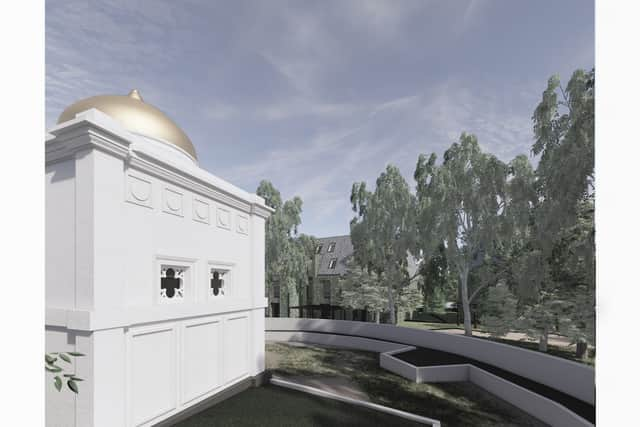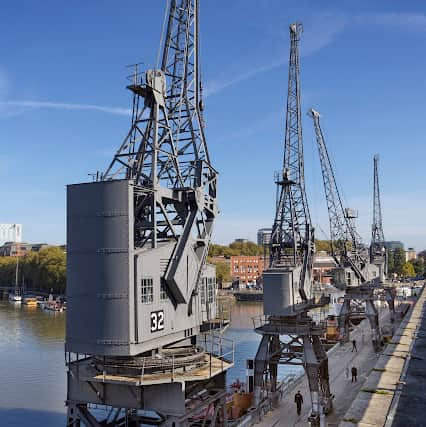The ten Bristol landmarks listed by Historic England in 2022
and live on Freeview channel 276
Bristol is a city rich with beautiful architecture and famous landmarks and 2022 saw Historic England designate ten of them Grade II listed status.
Six of the buildings singled out for special architectural or historic interest are located within the Bristol Zoo gardens, which closed to the public in 2022 ahead of the site being redeveloped.
Advertisement
Hide AdAdvertisement
Hide AdThe other four include a bronze statue in St Paul’s and two 17th Century buildings on Christmas Steps with a fascinating backstory.
Here is a round-up of the ten Bristol buildings and landmarks to be given Grade II status in 2022:
North entrance lodges with flanking walls and central link building at Bristol Zoo
The link building between the two lodges built in 1836 was designed by CFW Dening and added in 1934. The north entrance lodges are listed at Grade II for their ‘sophisticated pavilion design in the neoclassical style’.
Elephant and Giraffe House at Bristol Zoo
Built in 1872 in a Tudor gothic revival style, the elephant and giraffe house was attributed to the architect Charles Hansom. Both the 1964 brick extension to the north and the modern gorilla enclosure inserted into the interior are excluded from the listing.
South entrance gates and flanking walls to Bristol Zoo
Advertisement
Hide AdAdvertisement
Hide AdThe south entrance gates of the zoo are listed at Grade II ‘as a good example of a mid-19th Century cast-iron entrance gate displaying good architectural quality in its design and craftsmanship’.
The Monkey Temple at Bristol Zoo
The Monkey Temple was built in 1928 in a Mughal style and thought to have been designed by Dr Richard Clarke and inspired by both Carl Hagenbeck’s Monkey Rock at Tierpark, Germany, and the Cold Lairs, an old deserted city occupied by monkeys, in Rudyard Kipling’s The Jungle Book.


Former Bear Pit at Bristol Zoo
Built in about 1836 in a classical architectural style, the structures, fixtures and fittings associated with its use as an aquarium are not included in the listing. It is listed at Grade II for its ‘accomplished architectural design and composition in a classical style with good attention to architectural detailing, form and massing’. It is also the earliest surviving example of a bear pit associated with the first phase of zoological gardens in England during the 1830s, and its overall rarity as an animal house of this period.
Eagle Aviary at Bristol Zoo
Built in 1962 and designed by Saxon, Smith and Partners, the Eagle Aviary is listed at Grade II as an ‘accomplished example of a 1960s animal enclosure that reflects the architectural design approach of the period to design animal enclosures that reflected the character traits of its inhabitants’.
Cranes and rails on Prince’s Wharf
Advertisement
Hide AdAdvertisement
Hide AdThe group of four Stothert and Pitt high-speed electric cranes date from 1951 and are the second largest ensemble of historic cranes in the country. They are also the only group of Stothert and Pitt travelling cranes known to be in working order and a reminder of the important industrial function of the Docks, upon which Bristol’s prosperity was founded.


Statue of Alfred Fagon, junction of Ashley Road and Grosvenor Road, St. Pauls
Dating from 1987, the bronze bust of playwright and actor Alfred Fagon was created by Zimbabwean sculptor David Matusa. It is fixed to a polished black marble plinth and a tribute to one of the most notable Black British playwrights of the 1970s and 1980s.
Canon’s House, Canons Way
The offices for Lloyds Bank were designed by Arup Associates in 1986-1987 and built in two phases between 1988-1991. Historic England awarded the building Grade II status as they are a ‘pivotal element within the post-industrial repurposing of Bristol’s docks which, together with the integrated amphitheatre, forms a monumental and distinctive harbourside landmark’.
6 and 7 Christmas Steps
These two timber-framed houses from the 17th Century may have even earlier origins and are listed at Grade II. They have an association with Carlos Trower, professionally known as ‘The African Blondin’, a high rope artist of national repute in the late 19th Century who lived at 7 Christmas Steps in the 1870s. They are also part of ‘one of the best surviving medieval streets in Bristol which have largely otherwise been lost to development and bomb damage’.
Comment Guidelines
National World encourages reader discussion on our stories. User feedback, insights and back-and-forth exchanges add a rich layer of context to reporting. Please review our Community Guidelines before commenting.
